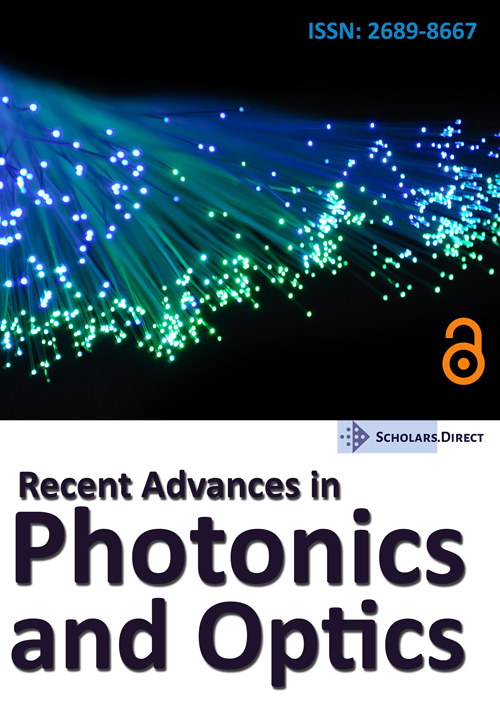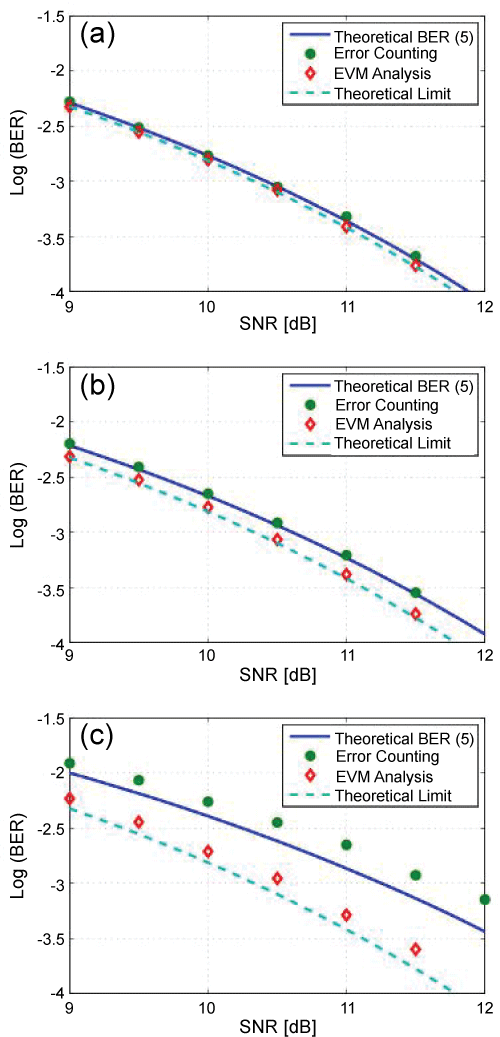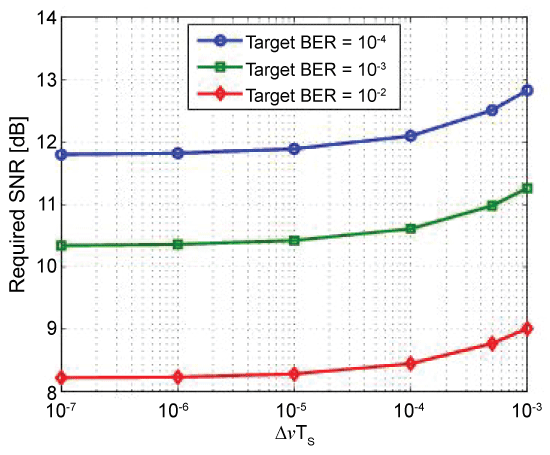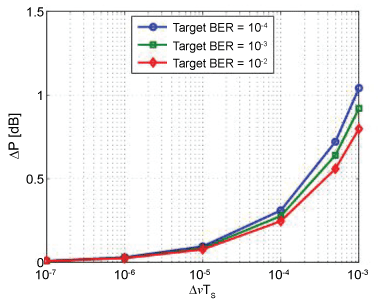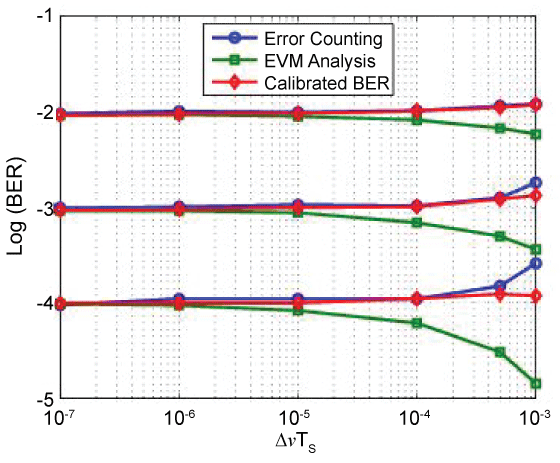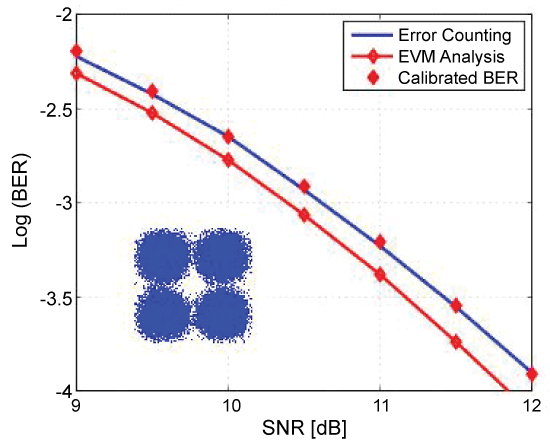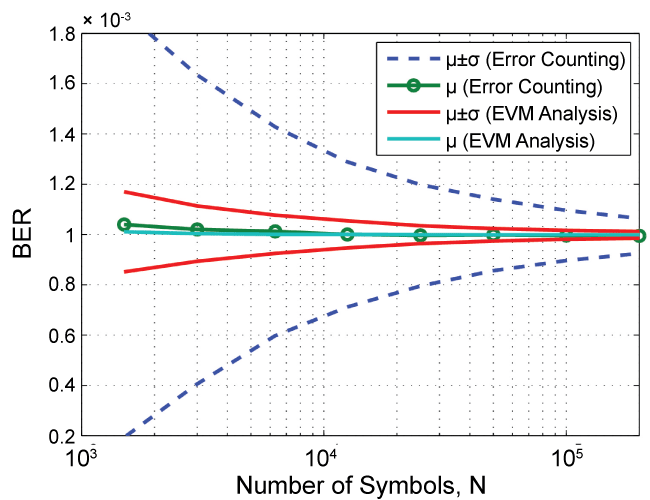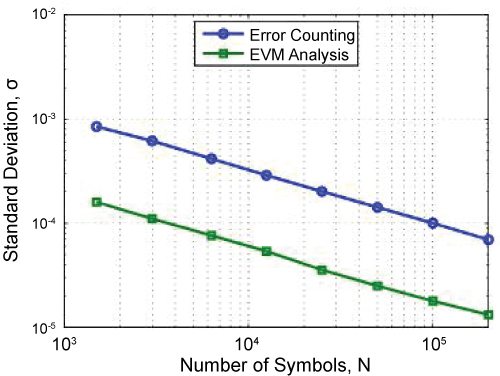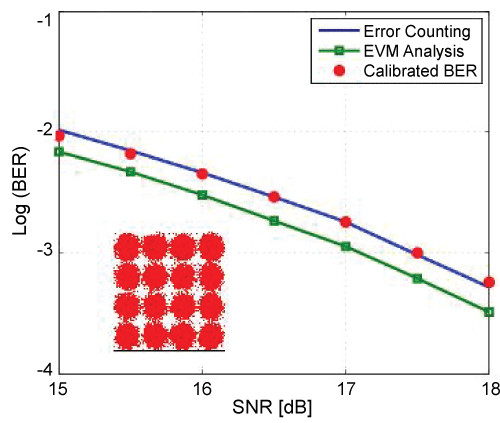Calibration of Estimated BER from Error Vector Magnitude with Carrier Phase Recovery
Abstract
This paper presents the estimation of bit error ratio (BER) from error vector magnitude (EVM) for the quadrature phase shift keying (QPSK) modulation format with the Viterbi & Viterbi algorithm and differential decoding to compensate for laser phase noise. It is demonstrated analytically and through simulation that a calibration is necessary when using the established relationship between EVM and BER to take into account the implementation penalty associated with the carrier phase recovery algorithm. Simulation results using the proposed calibration technique are presented for different combined linewidth symbol duration product in a QPSK coherent system. The impact on the number of symbols used to estimate the BER from EVM analysis is also investigated and compared to error counting. An estimation with lower uncertainty is demonstrated to be achievable with EVM analysis compared to error counting for different number of symbols. Finally, the estimation of BER for a 16-ary quadrature amplitude modulation (16-QAM) optical coherent system is investigated using the blind phase search algorithm for carrier phase recovery.
Keywords
Error Vector Magnitude (EVM), Quadrature Phase Shift Keying (QPSK), Carrier phase recovery
Introduction
Advanced modulation formats are currently receiving renewed interest for the next-generation of optical communication systems [1]. In particular, the quadrature phase shift keying (QPSK) modulation format has attracted a lot of research interest to increase data capacity due to its robustness to linear impairments and optical signal-to-noise ratio requirements [2,3]. With information encoded on both the amplitude and phase of the optical carrier, accurate metrological tools need to be developed to quantify the performance of optical QPSK coherent systems. A plethora of performance metrics can be used in optical communications to assess the quality of spectrally-efficient modulation formats [4-8]. The performance of the transmitted signal can be evaluated using metrics such as bit error ratio (BER), Q-factor, eye diagram and, more recently, error vector magnitude (EVM) [9]. BER is the most conclusive figure of merit compared to the other performance metrics. However, it requires a known pattern, e.g. a training sequence, to be transmitted for continuous performance monitoring in optical networks. EVM is a popular performance metric in wireless digital communication systems and is commonly used to evaluate the quality of vector-modulated signals [10] and is a more suitable figure of merit at high optical signal-to-noise ratio (OSNR) in coherent systems where a large number of symbols will otherwise be required for accurate error counting.
In this paper, the estimation of BER from EVM analysis is first presented for the QPSK modulation format with the Viterbi & Viterbi algorithm and differential decoding for different combined linewidth symbol duration product, ∆νTs. A calibration is shown to be necessary when using the established relationship between EVM and BER to take into account of the implementation penalty associated with the carrier phase recovery algorithm in optical coherent systems. The EVM analysis is shown to give better accuracy than error counting for different number of symbols. Finally, the estimation of BER from EVM analysis is presented for a 16-ary quadrature amplitude modulation (16-QAM) optical coherent system.
Error Vector Magnitude and BER Estimation
Error vector magnitude is extensively applied as a performance metric for digital wireless communication systems and is commonly defined as the root-mean-square (rms) value of the difference between a collection of ideal transmitted symbols and the received symbols in the I-Q plane [11,12]. The rms EVM can be expressed as [12]
Where Pa is the average transmitted power for the chosen modulation, tk is the transmitted vector, rk is the received signal vector and N is the number of symbols over which the EVM is estimated. The vector tk can either be a known reference pattern for data-aided EVM calculation or computed relative to the closest symbol in the constellation for non data-aided EVM calculation. EVM is related to signal-to-noise ratio (SNR) as follows [11]
for data-aided calculation. For the QPSK modulation format and differential decoding, where the EVM is caused only by amplified spontaneous emission (ASE) noise, the BER can be estimated using [11]
where a factor of 2 has been included for the differential coding penalty and erfc is the complementary error function. Although the relationship (3) is valid for data-aided EVM calculation, it can also be applied to non data-aided EVM calculation for BER < 10-2 as discussed in [6]. The performance of (3) with carrier phase recovery is discussed in the next section.
BER Estimation with Carrier Phase Recovery
The feed forward Viterbi & Viterbi algorithm (VVA) is the widely adopted scheme for the QPSK modulation format in digital coherent receivers for carrier phase recovery. The estimated phase, φ, using the VVA can be obtained using [13]
where Nb is the averaging block size. The VVA is typically followed by differential decoding to solve the four-fold phase ambiguity and also to avoid cycle slips. The analytical expression for the BER of a differentially encoded QPSK signal using the VVA with block averaging can be approximated as [14]
where γs is the SNR, P∆φ (ϵ) is the Gaussian probability density function of the phase estimation error with zero mean and variance [14]
where
The optimum block size, Nopt, to minimize the standard deviation of the phase estimation error is given as [14]
The above analytical approximation for the BER with the optimum block size is compared in Figure 1 with the estimated BER from EVM analysis and error counting for different values of ∆νTs. The theoretical limit with differential decoding is also shown for comparison. The phase noise in the simulation was modeled as the Wiener process [15]
where νi's are independent and identically distributed (i.i.d) random Gaussian variables with zero mean and variance
The simulation was performed over 200,000 symbols with non data-aided EVM calculation. The theoretical BER with phase noise was found to be in good agreement with error counting except for ∆νTs = 10-3 due to the assumption of small phase estimation error in (5). The BER estimated from EVM analysis, however, can be seen to deviate from error counting as the implementation penalty associated with the carrier phase recovery algorithm is not included in (3). Similar results were reported in [8] for QPSK transmission experiments where the BER obtained from EVM analysis was found to be underestimated compared to error counting. It is noted that similar underestimation is also observed for non-differential decoding, however it is anticipated that installed systems will employ differential decoding to mitigate cycle slips.
The BER obtained from EVM analysis using (3) must therefore be calibrated to reliably estimate the actual BER with carrier phase recovery. From (2) and (3), it can be seen that the calibration can be achieved by scaling the estimated SNR from EVM analysis when calculating the BER as follows
where ∆P is the implementation penalty in dB associated with the carrier phase recovery algorithm at the calibration point. Figure 2 shows the required SNR to achieve the target BER of 10-4, 10-3 and 10-2 using the analytical approximation (5). The block size was optimized according to (7) for the different values of ∆νTs. Figure 3 shows the corresponding implementation penalty, ∆P, relative to the theoretical limit with differential decoding for the respective target BER. Calibration results using (10) with the analytical approximation of ∆P are presented in the next section for different values of ∆νTs.
Calibration Results
The results shown in Figure 1 reveal that the relationship (3) underestimates the BER depending on the value of ∆νTs. Calibrating the BER estimated from EVM analysis is thus necessary to reliably monitor the performance of QPSK coherent systems. The calibrated BER is compared to the estimated BER from EVM analysis and error counting in Figure 4 for different values of ∆νTs. The required SNR shown in Figure 2 was used to achieve the target BER of 10-4, 10-3 and 10-2 in the simulation. The estimated BER from EVM analysis using (3) can be seen to deviate from error counting for ∆νTs > 10-5 where the implementation penalty ∆P associated with the carrier phase recovery should be considered for accurate results. The calibration technique (10) with the analytical values of ∆P can be seen to significantly improve the accuracy of the estimated BER from EVM analysis in Figure 4 except for ∆νTs = 10-3 where the analytical approximation is less accurate. Nevertheless, the calibrated BER can be seen to give a closer estimate to error counting, in particular, at the target BER of 10-2 and 10-3 compared to the estimated BER from EVM analysis without calibration.
It should be noted that the value of ∆P can also be obtained by comparing the performance of (10) with error counting as part of a calibration process instead of using the analytical approximation. Such approach would be useful, for example, when the implementation penalty in the transmission system is higher than the analytical value of ∆P associated with the carrier phase recovery algorithm. Figure 5 shows the performance for ∆νTs = 10-4 where the optimum value of ∆P was determined by minimizing the difference between the BER estimated from (10) and error counting at the target BER of 10-3. As it can be seen, the calibration technique (10) can reliably monitor the optical performance over an SNR range of at least 3 dB with ∆P determined by comparing (10) and error counting at the calibration point.
Next, the simulation was performed over 1000 trials to investigate the impact of using different number of symbols on the estimation of the BER from EVM analysis and error counting at the target BER of 10-3 as shown in Figure 6. The mean BER values, μ, over the 1000 trials can be seen to be similar for both estimators with N > 10,000. However, from the curve bands, μ ± σ, where σ is the standard deviation, it can be seen that an estimation with lower uncertainty can be achieved from EVM analysis compared to error counting. The standard deviation of the estimated BER from EVM analysis is compared to error counting in Figure 7 for different number of symbols. As it can be seen, the estimation of BER from EVM analysis is significantly better than error counting. The above simulation results demonstrate that the calibrated BER can potentially be a useful figure of merit to reliably monitor the optical performance of coherent systems with EVM analysis as opposed to the large number of symbols that may be required for accurate error counting. The estimation of BER from EVM analysis is discussed in the next section for 16-QAM.
BER Estimation with Carrier Phase Recovery for 16-QAM Coherent Systems
For M-ary square QAM constellations, the BER can be estimated using [11]
where the differential coding penalty, F, is given as [16]
For QPSK and 16-QAM, the values of F can thus be set to 2 and 1.67, respectively, to include the expected differential decoding penalty for the different modulation formats. Note that equation (11) reduces to (3) for the QPSK modulation format. The carrier phase recovery was implemented using the feed forward blind phase search algorithm [15] which is applicable to arbitrary M-QAM constellations and suitable for real-time implementation with high linewidth tolerance. The number of test phases was set to 32 with a filter half width of 9 as discussed in [15] for 16-QAM. The simulation was performed over 200,000 symbols.
Figure 8 shows the estimated BER from EVM analysis for the 16-QAM coherent system with ∆νTs set to 10-4. As it can be seen, the BER is also underestimated for 16-QAM with carrier phase recovery. Following a similar calibration approach as (10) for QSPK, the implementation penalty, ∆P, can also be included in (11) to calibrate the estimated BER for 16-QAM. The calibrated BER with ∆P = 0.4 dB can be seen to be in good agreement with error counting in Figure 8. The value of ∆P was determined by comparing the estimated BER from EVM analysis with error counting at the target BER of 10-3. The above calibration approach is thus equally applicable to 16-QAM optical coherent systems with carrier phase recovery when estimating the BER from EVM analysis.
Conclusions
The estimation of BER from error vector magnitude analysis has been demonstrated for the QPSK modulation format with carrier phase recovery and differential decoding. The laser phase noise was compensated using the widely adopted Viterbi & Viterbi algorithm with block averaging. Analytical and simulation results demonstrate that a calibration is necessary for accurate BER estimation with ∆νTs > 10-5 to take into account the implementation penalty associated with the carrier phase recovery algorithm. The impact on the number of symbols used to estimate the BER from EVM analysis has also been presented. An estimation with lower uncertainty can be achieved with EVM analysis compared to error counting. Finally, the calibration approach was shown to be equally applicable to 16-QAM optical coherent systems.
Acknowledgment
The work reported in this paper was funded by project EMPIR 14IND13 PhotInd. This project has received funding from the EMPIR programme co-financed by the Participating States and from the European Union's Horizon 2020 research and innovation programme.
References
- Winzer PJ (2012) High-Spectral-Efficiency Optical Modulation Formats. J Lightwave Technol 30: 3824-3835.
- Savory SJ (2010) Digital Coherent Optical Receivers: Algorithms and Subsystems. IEEE J Select. Topics Quantum Electron 16: 16: 1164-1179.
- Fludger C, Duthel T, van den Borne D, et al. (2008) Coherent Equalization and POLMUX-RZ-DQPSK for Robust 100-GE Transmission. J Lightwave Technol 26: 64-72.
- Jacobs SA, Marsland RA (2016) Constellation recovery and impairment evaluation through minimization of the blind EVM. Opt Express 24: 21708-21721.
- Ives DJ, Thomsen BC, Maher R, et al. (2011) Estimating OSNR of equalised QPSK signals. Opt Express 19: 661-666.
- Schmogrow R, Bernd N, Marcus W, et al. (2012) Error vector magnitude as a performance measure for advanced modulation formats. IEEE Photon Technology Lett 24: 61-63.
- Sunnerud H, Skold M, Westlund M, et al. (2012) Characterization of Complex Optical Modulation Formats at 100 Gb/s and Beyond by Coherent Optical Sampling. J Lightwave Technol 30: 3747-3759.
- Zhang F, Luo Y, Wang Y, et al. (2011) Experimental Comparison of Different BER Estimation Methods for Coherent Optical QPSK Transmission Systems. IEEE Photon Technology 23: 1343-1345.
- Freude Wolfgang, Rene Schmogrow, Nebendahl Bernd, et al. (2012) Quality metrics for optical signals: eye diagram, Q-factor, OSNR, EVM and BER. 14th International Conference on Transparent Optical Networks, United Kingdom, 4.
- IEEE Standard for Wireless LAN Medium Access Control (MAC) and Physical Layer (PHY) Specifications: High-Speed Physical Layer in the 5 GHz Band, IEEE Standard 802.
- Shafik, Rishad Ahmed, Rahman, et al. (2006) On the extended relationships among EVM, BER and SNR as performance metrics. International Conference on Electrical and Computer Engineering, Bangladesh, 408-411.
- Arslan Huseyin, Mahmoud Hisham A (2009) Error vector magnitude to SNR conversion for nondata-aided receivers. IEEE Trans. Wireless Commun 8: 2694-2704.
- Ly-Gagnon Dany, Tsukamoto Satoshi, Katoh Kazuhiro, et al. (2006) Coherent detection of optical quadrature phase-shift keying signals with carrier phase estimation. J Lightwave Technol 24: 12-21.
- Goldfarb G, Li G (2006) BER estimation of QPSK homodyne detection with carrier phase estimation using digital signal processing. Opt Express 14: 8043-8053.
- Pfau Timo, Hoffmann Sebastian, Noe Reinhold (2009) Hardware-Efficient Coherent Digital Receiver Concept With Feedforward Carrier Recovery for $M$-QAM Con- stellations. J Lightwave Technol 27: 989-999.
- W Weber (1978) Differential encoding for multiple amplitude and phase shift keying systems. IEEE Transactions on Communications 26: 385-391.
Corresponding Author
Irshaad Fatadin, National Physical Laboratory, Teddington, UK.
Copyright
© 2017 Fatadin I. This is an open-access article distributed under the terms of the Creative Commons Attribution License, which permits unrestricted use, distribution, and reproduction in any medium, provided the original author and source are credited.

